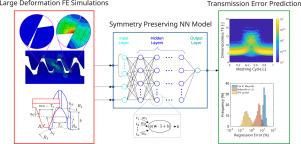基于神经网络的聚合物齿轮加载齿接触有限元模型研究
IF 4.5
1区 工程技术
Q1 ENGINEERING, MECHANICAL
引用次数: 0
摘要
介绍了一种用于聚合物齿轮加载齿接触分析的神经网络模型。神经网络模型在10,000个有限元(FE)模拟中进行训练,这些模拟利用大变形框架并跨越17维输入空间,包括几何形状,材料和负载相关参数。结合参数网格方案和鲁棒隐式求解器实现实现静态传动误差(STE)曲线的自动提取。利用周期性的对称性和从有维参数空间到无维参数空间的转换,一个大约有9000个参数的全连接神经网络在1000条以前未见过的STE曲线的测试集上实现了0.49%的平均绝对百分比误差。与典型的、解析的、基于物理的求解器相比,该误差代表了对有限元结果的更精确复制的一个数量级,并且更忠实地预测了角接触的影响。神经网络模型的计算成本与简单的线性近似公式相当,这表明数据驱动的方法比基于物理的有限元模拟方法更准确,计算强度更低。本文章由计算机程序翻译,如有差异,请以英文原文为准。

Neural network surrogates for finite element models in loaded tooth contact analysis of polymeric gears
This paper introduces a neural network (NN) model for loaded tooth contact analysis in polymeric gears. The NN model is trained on 10,000 finite element (FE) simulations, which utilize a large deformation framework and span a 17-dimensional input space, including geometry, material and load related parameters. Combining a parametric meshing scheme and a robust implicit solver implementation enables the automated extraction of static transmission error (STE) curves. Leveraging the symmetry of periodicity and a conversion from a dimensional to a dimensionless parametric space, an approximately 9,000-parameter fully connected neural network achieves a mean absolute percentage error of 0.49% on a test set of 1,000 previously unseen STE curves. This error represents an order of magnitude more accurate replication of FE results than typical, analytical, physics-based solvers, with the effects of corner contact being predicted more faithfully. The computational cost of the NN model remains comparable to simple, linearly approximated formulas, indicating that data-driven approaches can be both more accurate and less computationally intensive than physics-based surrogates to FE simulations for large deformations.
求助全文
通过发布文献求助,成功后即可免费获取论文全文。
去求助
来源期刊

Mechanism and Machine Theory
工程技术-工程:机械
CiteScore
9.90
自引率
23.10%
发文量
450
审稿时长
20 days
期刊介绍:
Mechanism and Machine Theory provides a medium of communication between engineers and scientists engaged in research and development within the fields of knowledge embraced by IFToMM, the International Federation for the Promotion of Mechanism and Machine Science, therefore affiliated with IFToMM as its official research journal.
The main topics are:
Design Theory and Methodology;
Haptics and Human-Machine-Interfaces;
Robotics, Mechatronics and Micro-Machines;
Mechanisms, Mechanical Transmissions and Machines;
Kinematics, Dynamics, and Control of Mechanical Systems;
Applications to Bioengineering and Molecular Chemistry
 求助内容:
求助内容: 应助结果提醒方式:
应助结果提醒方式:


